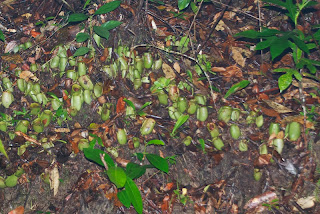The most remarkable frogs I saw at at Kubah National Park during my night visits in October 2012 were not at the frog pond, the subject of my last entry, but just across the road to the park summit at Gunung Serapi. Here is Daniel Kong, who showed them to me, photographing them literally on the edge of the pavement - and yet this is a species scientists first described only in 2010.
You can see one of them here - a tiny creature, perched on the edge of a leaf on the forest floor.
Meet Microhyla nepenthicola, the Matang Narrow-mouthed Frog - at under 13 mm, one the smallest frogs in the world. It was thought at first to be the smallest frog in Southeast Asia, but Indraneil Das (one of the describers of this species) tells me that there is a still-undescribed frog, also from Kubah, that is even smaller!
These frogs had been known for a long time, but they were so tiny that they were thought to be juveniles of a larger species. Here is our little male from the leaf edge, proving them wrong by singing.
For more proof, here is another male clinging to the back of a (much larger) female. This is amplexus, or what frogs do when they mate.
The mating pair can be hard to spot against the leaf litter!
The proper name of this frog has been the subject of some confusion. There are a number of Microhyla frogs in Borneo, including two described species in Kubah, a larger one and a smaller one (not counting the even smaller, undescribed one mentioned earlier). This is the smaller of them, and when Indraneil Das and Alexander Haas first named it they identified the larger one as M. borneensis, a species that had already been named. However, in 2011 Masafumi Matsui found that the type specimen of borneensis - the one on which the name was based - was an example not of the larger frog, but the smaller one.
Under the Rules of Zoological Nomenclature, that meant that the smaller frog had to be renamed Microhyla borneensis,
because that was the older name, and the larger one - which now did not
have a scientific name at all - had to be given a new one. Matsui christened it Microhyla malang. However, the type of borneensis that Matsui examined had not come from Kubah, but from an area further inland near the town of Bau. Indraneil Das tells me that these Bau frogs are genetically distinct from our small frogs from Kubah, and to add to the confusion, there appear (as of May 2014) to be two further undescribed Microhyla species in the Bau-Kuching region. That means, I think, that the little frogs in these pictures should be called Microhyla nepenthicola after all.
Names aside, the most interesting thing about this frog is where it chooses to breed. M. malang (if that is the correct name for the bigger one) has fairly orthodox breeding habits, depositing its eggs in temporary stagnant pools. M. nepenthicola lays its eggs, instead, in the liquid-filled traps of the pitcher plant Nepenthes ampullaria.
That's why it is called nepenthicola, which means, roughly, 'hanging around near pitcher plants'. This frog is, to be technical, an obligate nepenthophile, utterly dependent on the plant (which, fortunately for the frog, grows in dense clumps on the forest floor).
The tadpoles hatch inside the pitchers (either in mature traps, as in the upper photo, or fading ones, as in the lower) and remain there, safe in their tiny aquaria, eating nothing but living on the yolk stored in their guts, until they emerge as young frogs to live out their lives, it seems, close to their peculiar nurseries. Remarkable creatures, indeed.

+DSC_4874.jpg)
+DSC_4890.jpg)
+DSC_4881.jpg)
+DSC_4887.jpg)
+DSC_4926.jpg)
+DSC_4922.jpg)
+DSC_4893.jpg)
+DSC_4905.jpg)


+DSC_5112.jpg)
+DSC_5113.jpg)
No comments:
Post a Comment